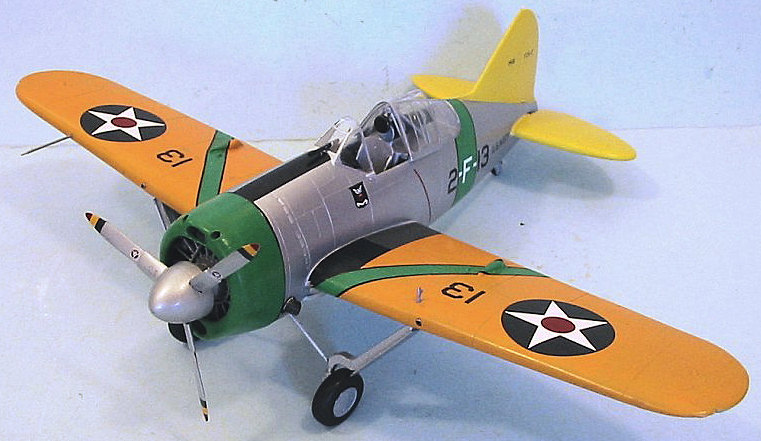
| KIT: | Special Hobby 1/32 Brewster F2A-2 Buffalo |
| KIT #: | ? |
| PRICE: | $54.00 MSRP |
| DECALS: | Two options |
| REVIEWER: | Tom Cleaver |
| NOTES: | Yellow Wings Decals used |

| HISTORY |
By the late 1930s, everyone in U.S. Naval Aviation was aware that the fighting biplane was obsolete, though there were those who believed it would be impossible to marry the high performance of a monoplane with the requirements of carrier operations. In late 1937, the Bureau of Aeronautics put forward a set of requirements for an F3F replacement that - like those which resulted in the SB2U-1 - did not necessarily call for a monoplane.
In fact, Grumman was asked to submit a biplane design, the XF4F-1. Grumman did so grudgingly, but soon managed to convince the powers-that-be that with a little detail refinement to the F3F-2 and a higher-powered R-985, the requested performance for the XF4F-1 could be bettered. This resulted in Grumman delivering the last Navy biplane fighter, the F3F-3, and allowed the company to design and submit a monoplane, the XF4F-2.
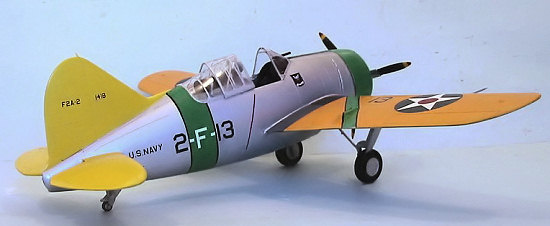 How the U.S. Navy managed
as a result of the competition to not only allow Brewster - a company that had
begun by making buggies a hundred years earlier and had never yet produced a
successful aircraft design - to enter a design, but chose that over the
submission of the premier Naval aircraft manufacturer is one of those anomalies
of aviation history that makes things interesting. Nevertheless, the XF4F-2 was
beaten by the XF2A-1, and Brewster Aircraft Company received the contract to
take the Navy into the next generation of combat aircraft.
How the U.S. Navy managed
as a result of the competition to not only allow Brewster - a company that had
begun by making buggies a hundred years earlier and had never yet produced a
successful aircraft design - to enter a design, but chose that over the
submission of the premier Naval aircraft manufacturer is one of those anomalies
of aviation history that makes things interesting. Nevertheless, the XF4F-2 was
beaten by the XF2A-1, and Brewster Aircraft Company received the contract to
take the Navy into the next generation of combat aircraft.
A more unlikely source would be hard to imagine. The company had no understanding of how to mass-produce an airplane. The two-story factory did not have elevators, and the completed fuselages, which were hand-assembled on the second floor, were lowered by a hay baler type of winch to the lower floor. Once there and completed, there was no airport to test the airplanes, which had to be towed several miles to the Buffalo airport.
Needless to say, Brewster was behind schedule by the time they delivered the first production F2A-1 in the late summer of 1939 and never did catch up throughout the entire production run of the F2A series.
VF-3, the squadron chosen to be the first to equip with the new fighter, had only received six of them when the entire rest of the 54-aircraft production run for the F2A-1 was diverted to Finland with the outbreak of the Winter War in November 1939. The squadron flew on with six F2A-1s and 12 F3F-1s until the summer of 1940, when they were able to re-equip with the F2A-2, which also allowed VF-2 - The Flying Chiefs - to replace their thoroughly-antiquated Grumman F2F-1s.
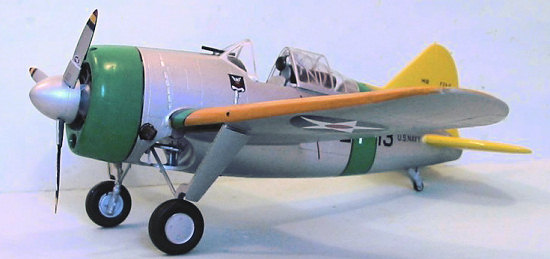 The F2A-2 was likely the
best version overall in terms of performance, and was also produced for export
as the Model 339, seeing service with the RAF at Singapore, and with the Dutch
in the Netherlands East Indies. The Model 339 was thoroughly outperformed by
its opponents, though it might have seen better service had the RAF and the
Dutch used tactics similar to those developed by the American Volunteer Group,
which would have kept pilots from attempting to “dogfight” in an airplane too
heavy and too underpowered for that kind of fighting.
The F2A-2 was likely the
best version overall in terms of performance, and was also produced for export
as the Model 339, seeing service with the RAF at Singapore, and with the Dutch
in the Netherlands East Indies. The Model 339 was thoroughly outperformed by
its opponents, though it might have seen better service had the RAF and the
Dutch used tactics similar to those developed by the American Volunteer Group,
which would have kept pilots from attempting to “dogfight” in an airplane too
heavy and too underpowered for that kind of fighting.
Some of the remaining F2A-1s were returned to the factory to be modified to F2A-2 standards in late 1940, but at least one survived as an F2A-1 until the summer of 1942, when it crashed at NAS Miami where it was being used as an advanced trainer. The F2A-2s ended their days as advanced fighter trainers at NAS Miami, where the aircraft’s weak landing gear resulted in all of them being eventually written off.
| THE KIT |
Prior to the release of this kit, the only 1/32 F2A was a resin “garage kit” originally created by Jerry Rutman, which has been unavailable for several years and would be in any case completely outdated by this release from Special Hobby. It is interesting to note that the MPM Website shows the F2A-1/Model 329 “Finnish Buffalo” and Model 339E “RAF Buffalo” as future releases, so the entire series will be available in this larger scale in the foreseeable future.
On opening the box, it is easy to answer the question “Who’s your daddy?” This
kit is basically the 1/48 Classic Airframes kit - which was designed and
produced by MPM - pantographed up to 1/32 scale, with almost all the resin parts
of the earlier kit now 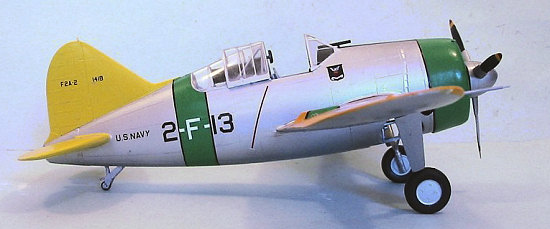 produced
in injection plastic.
produced
in injection plastic.
The kit includes the separate windscreen and different sliding canopy for the other Buffalo versions. The clear plastic of these parts is very clear, and thin enough to pose the sliding canopy open. I found it interesting that, in this large scale, the canopy is finally produced as it really was on the full-scale airplane, with a different cross section fore and aft, and with the rear fixed canopy more curved in cross section than it has been done as in the smaller scales.
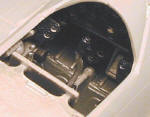 As
is now usual with the Special Hobby/Azure 1/32 kits, the cockpit is now done in
injection plastic, but will be undoubtedly released in the future as a resin
“hi-tech” release. Not to panic. All these parts are fine, and photoetch
detail parts for the instrument panels and seat belts is provided.
As
is now usual with the Special Hobby/Azure 1/32 kits, the cockpit is now done in
injection plastic, but will be undoubtedly released in the future as a resin
“hi-tech” release. Not to panic. All these parts are fine, and photoetch
detail parts for the instrument panels and seat belts is provided.
The decals are acceptable. They provide markings for the Squadron Commander’s airplane of VF-2, and for the Number 8 airplane of VF-3. The VF-3 “Felix the Cat” insignia is wrong because it does not provide white for the facial detail of Felix. Fortunately, Yellow Wings Decals is producing a sheet of decals for this kit that will allow a modeler to make any F2A-2, with the correct squadron markings. I suggest you pick that sheet up, since it will be available by the end of October.
| CONSTRUCTION |
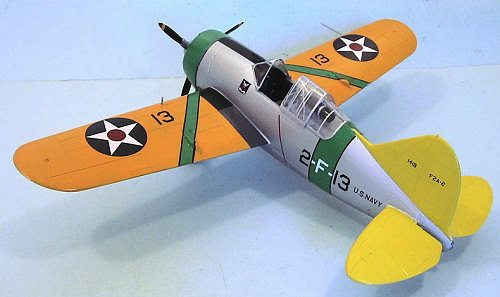 Test-fitting of parts
showed that the kit fits better than the 1/48 Classic Airframes kit did. As
Bill Koppos pointed out in his review, one needs to test fit all parts before
assembling them, since this is a limited-run kit.
Test-fitting of parts
showed that the kit fits better than the 1/48 Classic Airframes kit did. As
Bill Koppos pointed out in his review, one needs to test fit all parts before
assembling them, since this is a limited-run kit.
I started construction of this kit by assembling the wings, which involves assembling the gear well, with the separate wing ribs, each of which needs to be test-fitted once the wing spar is attached in position. Once I had the wings assembled, I also assembled the horizontal stabilizers.
The major part of construction on this kit is the fuselage. I pre-painted everything with SNJ Aluminum, then proceeded to assemble the cockpit, and then the engine accessory compartment/wheel well area. Once everything was solidly in position, it turned out I still needed to knock a bit off of the various bulkheads with a sanding stick to get the fuselage halves to join up on the centerline. Once that was done, I attached the wings and horizontal stabilizers, and then applied a good coat of Mr. Surfacer 500 to all the joints and seams.
 While all that was setting up, I assembled the engine, which is nicely detailed
out of the box, but can look even better with additional detail added on like
Bill Koppos did in his review.
While all that was setting up, I assembled the engine, which is nicely detailed
out of the box, but can look even better with additional detail added on like
Bill Koppos did in his review.
Once everything had been sanded down and the seams had been defeated, I polished
the model overall since it was going to get a coat of metalizer paint. When
that was done, I attached the rear canopy and the w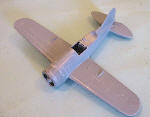 indscreen.
It turned out I needed to apply more Mr. Surfacer to the join area of the rear
canopy and then carefully sand that smooth and polish it again before
proceeding.
indscreen.
It turned out I needed to apply more Mr. Surfacer to the join area of the rear
canopy and then carefully sand that smooth and polish it again before
proceeding.
I masked the canopy glass with Tamiya tape, which was a laborious process of covering each panel. This was particularly laborious when masking off the lower clear panel.
I cut off the tip of the radio antenna and used that for the stub antenna on the left wing what distinguished VF-2 F2A-2s.
| COLORS & MARKINGS |
Painting:
I
used Tamiya Flat Yellow, lightened with Tamiya Flat White, to produce the “Lemon
Yellow” color that distinguished the Lexington Air Group. This was applied over
a base coat of Flat White applied to the horizontal stabilizers and vertical
fin. The 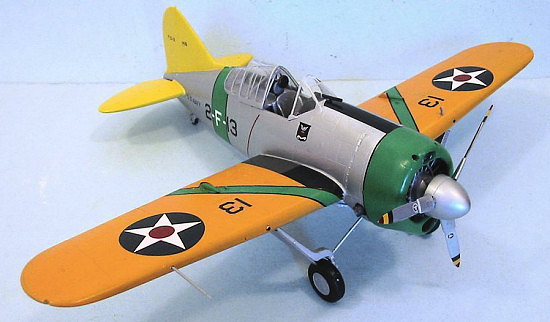 upper wings were
painted with Gunze-Sangyo “Orange Yellow” over a base coat of Flat White.
upper wings were
painted with Gunze-Sangyo “Orange Yellow” over a base coat of Flat White.
I had the devil’s own time matching the decal color for Willow Green, for the cowling stripe. Eventually, after realizing that the color I had and the color on the decals were never going to match up in final look, I painted the cowling, the fuselage belly stripe and the wing chevrons with a mixture that sort of/kind of approximates Willow Green, though I am still not completely happy with the final result.
Once all these areas were painted and masked over, I painted the rest of the model with SNJ Aluminum Paint. When that dried, I unmasked everything and gave the entire model a coat of Xtracrylix Gloss Varnish, which turned the “natural metal finish” into aluminum paint, which is what it should be for this aircraft.
Decals:
The Yellow Wings decals went on without any problem under a coat of Micro-Sol.
| FINAL CONSTRUCTION |
I unmasked all the canopy glass, and posed the canopy open. I found that “scraping down” the leading edge of the rear canopy to lower it just a little bit and make it just a little bit narrower made it far easier to pose the sliding canopy in the correct position.
I attached the landing gear, the prop and the exhausts without any problem.
| CONCLUSIONS |
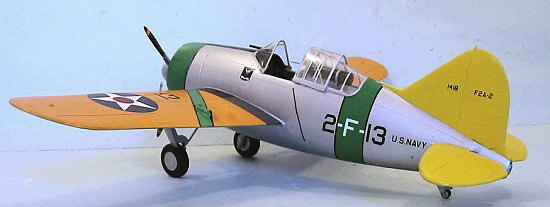 This kit was amazingly
popular, with its initial release at the 2006 IPMS-USA National Convention last
July. The first run was sold out at Hannant’s by late August, and a second run
delivered in late September disappeared equally quickly. The three that came in
to my local hobby shop in early September were gone by the end of that weekend.
Thus, several thousand of these kits are out there, but to date I have only seen
one built by Bill Koppos. That’s unfortunate, because this kit is much easier
to assemble than the Classic Airframes kit was, and results in a better-looking
model. This 1/32 F2A-2 is the most accurate kit of this famous airplane
released by anyone to date.
This kit was amazingly
popular, with its initial release at the 2006 IPMS-USA National Convention last
July. The first run was sold out at Hannant’s by late August, and a second run
delivered in late September disappeared equally quickly. The three that came in
to my local hobby shop in early September were gone by the end of that weekend.
Thus, several thousand of these kits are out there, but to date I have only seen
one built by Bill Koppos. That’s unfortunate, because this kit is much easier
to assemble than the Classic Airframes kit was, and results in a better-looking
model. This 1/32 F2A-2 is the most accurate kit of this famous airplane
released by anyone to date.
For those who model U.S. Navy fighters, the F2A-2 is a historically-significant airplane. Modelers with several limited-run kits under their belt who are willing to take their time during assembly will end up with an interesting addition to their “Golden Wings” collection.
March 2007
Review kit courtesy of Hannant’s. http://www.hannants.co.uk
If you would like your product reviewed fairly and quickly by a site that has over 350,000 visitors a month, please contact me or see other details in the Note to Contributors.